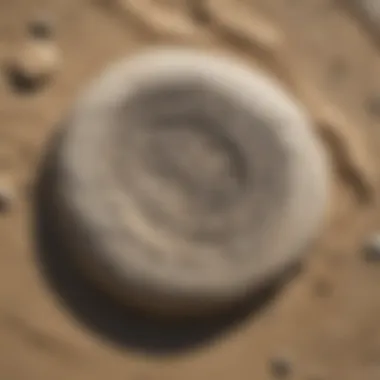Unlocking the Enigmatic Beach Stones: A Comprehensive Guide to Identification


Rock and Fossil Identification
As we embark on the journey of unlocking the mysteries of beach stones, it is imperative to first understand the basics of rock and fossil identification. Beach stones come in a wide variety of types, each with distinct characteristics that set them apart. From sedimentary to igneous rocks, and fossils that have undergone millions of years of transformation, recognizing these specimens is essential for any enthusiast. When scouring the shores for these geological treasures, paying attention to specific features such as color, texture, and composition is key to accurate identification. Utilizing tools like magnifying lenses, hardness picks, and UV light can further aid in the precise categorization of rocks and fossils.
Collecting Tips and Techniques
For rock and fossil collectors looking to enhance their collection, mastering the art of collecting is crucial. Implementing best practices ensures that specimens are gathered ethically and with the preservation of the environment in mind. Identifying prime collecting sites involves research on geological formations and past fossil discoveries. Once on-site, safely extracting specimens requires delicate techniques to prevent damage while excavating. Whether it's using specialized tools for extraction or documenting the exact location of a find, attention to detail is paramount.
Preservation and Display
Preserving rocks and fossils is a delicate process that requires careful consideration of techniques and storage methods. From cleaning and stabilizing to protecting specimens from environmental factors, proper preservation ensures longevity. When it comes to storage, utilizing acid-free archival materials and climate-controlled environments prevents deterioration over time. Creative display ideas offer enthusiasts the opportunity to showcase their collection in unique and visually appealing ways, fostering appreciation for these geological wonders.
Geological Insights
Delving deeper into the world of beach stones unveils fascinating geological insights. Understanding the formations and processes that led to the creation of these rocks and fossils provides context to their presence on the beach. Exploring the historical significance of certain specimens sheds light on the Earth's ancient past, offering a glimpse into the flora and fauna that once populated these landscapes. Notable discoveries in the field serve as a testament to the continuous exploration and revelation of our planet's geological history.
Introduction
The topic of beach stones is not only intriguing but also essential for individuals passionate about exploring the treasures hidden within geological formations. This comprehensive identification chart serves as a valuable resource for rock and fossil collectors of all levels. By delving into the world of beach stones, enthusiasts can gain a deeper understanding of these coastal gems and learn how to identify them accurately.
Understanding Beach Stones
Formation Processes
Formation processes are crucial in understanding the origins of beach stones. The specific aspect of formation processes sheds light on how these stones are created and altered over time, contributing significantly to the overall goal of identifying beach stones accurately. By highlighting the intricate details of formation processes, individuals can develop a keen eye for recognizing key characteristics that differentiate one stone from another. The unique feature of formation processes lies in their ability to provide valuable insights into the geological history encapsulated within each stone, offering both advantages and disadvantages in the realm of beach stone identification.
Types of Beach Stones
Exploring the various types of beach stones is essential for building a comprehensive knowledge base in this field. Understanding the different types enhances the ability to distinguish between them and appreciate their distinct features. Each type has key characteristics that make them stand out, making them a popular choice for inclusion in this article. By describing the unique features of each type, readers can grasp the advantages and disadvantages associated with them, facilitating a deeper understanding of beach stone identification.
Significance of Beach Stones
Geological Importance
The geological importance of beach stones lies in their ability to provide valuable insights into the Earth's history. By examining the specific aspect of geological importance, individuals can uncover crucial information about the formation and evolution of these stones. Highlighting the key characteristics of geological importance illuminates why it is a significant inclusion in this article, serving as a popular choice due to its relevance to beach stone identification. The unique feature of geological importance offers numerous advantages, although some disadvantages may also arise in the context of this comprehensive identification chart.
Ecological Role
The ecological role of beach stones goes beyond their aesthetic appeal, playing a vital part in the ecosystem. Examining the specific aspect of the ecological role offers a deeper understanding of how beach stones contribute to environmental processes. Highlighting the key characteristics of their ecological role showcases why it is an important element in this article, being a popular choice for its relevance to beach stone identification. Describing the unique features of their ecological role helps readers appreciate the advantages they bring, while also acknowledging any potential disadvantages within the scope of this comprehensive guide.
Characteristics of Beach Stones
In the vast realm of beach stones, understanding their distinct characteristics holds paramount importance. The topic of Characteristics of Beach Stones within this article serves as a foundational pillar in the comprehensive guide to unlocking the mysteries of these geological treasures. By delving into the intricate details of color, texture, size, and shape, rock and fossil enthusiasts can gain profound insights into the identification and classification of beach stones.


Color and Texture
Variances in Color
Exploring the variances in color of beach stones is a fundamental aspect of their identification. The hues present in stones can indicate specific mineral compositions and formation processes, offering valuable clues to their geological history. Understanding these color variations enables collectors to differentiate between different types of stones with precision, enhancing their overall beachcombing experience.
Texture Analysis
Analyzing the texture of beach stones provides a tactile dimension to their identification. Texture impacts how light interacts with the surface of a stone, influencing its appearance and feel. By conducting texture analysis, collectors can discern the smoothness, roughness, or intermediate textures of stones, aiding in their categorization and appreciation of the diverse range of beach stones.
Size and Shape
Measurement Techniques
Employing accurate measurement techniques is essential in the study of beach stone characteristics. Measuring the dimensions of stones allows collectors to document their size variations, which can be indicative of both geological processes and transportation mechanisms. Precision in measurement facilitates the identification of unique specimens and contributes to building comprehensive catalogues of beach stones.
Common Shapes
Exploring the common shapes found in beach stones offers valuable insights into their classification. Stones can exhibit diverse shapes ranging from rounded pebbles to angular forms, shaped by factors such as erosion and mineral composition. Understanding these common shapes equips collectors with the knowledge to recognize recurring patterns in nature, enhancing their ability to identify distinct types of beach stones.
Key Features for Identification
Unlocking the mysteries of beach stones hinges greatly on the ability to identify key features that distinguish one stone from another. This section of the comprehensive guide delves into the significance of honing in on these unique characteristics for accurate identification. Understanding the mineral composition, markings, and patterns of beach stones is crucial for enthusiasts and collectors in accurately cataloging and appreciating their finds. By focusing on key features, readers can develop a keen eye for detail, leading to a deeper understanding and connection with the geological world around them.
Mineral Composition
Silicate-Based Stones
Silicate-based stones play a pivotal role in the realm of beach stone identification. Known for their abundant presence and diverse characteristics, silicate-based stones offer a wide array of colors, textures, and patterns that make them a prime choice for collectors and researchers alike. With their unique chemical composition, including silica tetrahedra structures, these stones exhibit remarkable hardness and durability, making them ideal candidates for this article's exploration. The intricate lattice structures of silicate-based stones contribute to their distinctiveness and allure, providing detailed insight into their formation processes and geological significance.
Carbonate-Based Stones
Alternatively, carbonate-based stones offer a contrasting perspective in the realm of beach stone identification. Featuring calcium carbonate as their primary constituent, these stones showcase vibrant colors, distinct patterns, and varying levels of hardness. Their formation in marine environments lends them a unique charm, reflecting the interactions of organisms and minerals over time. Collectors are drawn to the diversity of carbonate-based stones, appreciating their intricate textures and fossilized imprints, which add an element of historical significance to their allure. While differing in composition from silicate-based stones, carbonate-based stones present an equally compelling narrative within the context of beach stone identification.
Unique Markings and Patterns
Inclusions and Veins
Exploring the intricate world of beach stones reveals the presence of unique markings such as inclusions and veins, which hold immense value in the identification process. Inclusions, characterized by foreign materials encapsulated within a stone's matrix, provide clues to its formation and geological history. Veins, on the other hand, represent the presence of mineral deposits that have filled fractures or fissures within a stone. These distinctive features not only enhance the aesthetic appeal of beach stones but also offer deeper insights into their origins and evolutionary pathways, enriching collectors' appreciation for the Earth's geological diversity.
Fossilized Imprints
Delving further into the realm of unique markings and patterns, fossilized imprints serve as invaluable indicators of ancient life forms preserved within beach stones. These imprints, ranging from plant remains to marine organisms, offer a glimpse into past ecosystems and environmental conditions. For enthusiasts and researchers, fossilized imprints present a rare opportunity to connect with the Earth's geological history on a tangible level, fostering a profound appreciation for the interplay between living organisms and geological processes. By recognizing and studying these fossilized remnants, collectors can unearth a wealth of knowledge and curiosity about the beach stones they encounter.
Tools and Techniques for Identification


When it comes to beach stone identification, having the right tools and techniques is paramount. In this article, we delve into the significance of utilizing specific elements that aid in accurately categorizing beach stones. By focusing on tools and techniques, we ensure a precise understanding of the compositions and unique features of various stones.
Magnifying Devices
Hand Lens
The Hand Lens plays a crucial role in magnifying and examining small details of beach stones. Its key characteristic lies in its portability and magnification capabilities, making it a popular choice for rock and fossil enthusiasts. The unique feature of the Hand Lens is its ability to provide a closer look at intricate patterns and inclusions present in beach stones, aiding in detailed identification processes. While it offers clarity and precision, one disadvantage is its limited magnification power for certain intricate patterns requiring more detailed inspection.
Microscope
The Microscope enhances the identification process by allowing for detailed analysis of beach stone samples. Its key characteristic is its high magnification power, facilitating the examination of tiny structures and compositions with utmost accuracy. The Microscope is a beneficial choice for this article as it enables thorough investigation of stone characteristics. The unique feature of the Microscope is its ability to reveal intricate details that may not be visible to the naked eye, providing in-depth insights for identification purposes. One disadvantage of using a Microscope is the need for specialized training to operate and interpret the results effectively.
Chemical Tests
Chemical tests serve as valuable tools for identifying beach stones based on their reactions to specific acids. The Acid Reactions test is crucial in determining the mineral composition of stones. Its key characteristic is its ability to differentiate between stones based on their acid reactivity, aiding in accurate classification. The unique feature of Acid Reactions is its role in identifying specific minerals present in beach stones, offering insights into their geological origins. One disadvantage is the potential harm that corrosive acids can pose if mishandled or not disposed of properly.
Streak Test
The Streak Test is a method used to determine the color of a mineral's powdered form, assisting in its identification. Its key characteristic lies in its simplicity and effectiveness in distinguishing mineral types based on streak colors. The unique feature of the Streak Test is its ability to reveal hidden colors that may not be apparent on the surface of a stone, providing additional clues for identification purposes. One disadvantage of the Streak Test is its reliance on the hardness of the mineral, which can sometimes lead to inconclusive results.
Online Resources
In the digital age, online resources serve as valuable aids in the identification of beach stones. Digital Databases offer a vast collection of information on various stone types, aiding enthusiasts in their quest for precise identification. Their key characteristic is the accessibility to a wide range of geological data, making them a popular choice for researchers and collectors. The unique feature of Digital Databases is the ability to cross-reference stone characteristics and origins, assisting in accurate identification. One disadvantage is the potential misinformation or lack of updated data that may exist in certain online databases.
Identification Forums
Identification Forums provide a platform for enthusiasts to seek advice, share insights, and collaborate on stone identification. Their key characteristic is the communal aspect, where individuals can engage with a community of like-minded collectors to discuss and validate their findings. The unique feature of Identification Forums is the real-time feedback and diverse perspectives offered by members, contributing to a collective understanding of beach stone identification. One disadvantage is the reliance on subjective opinions, which may lead to discrepancies in identification results.
Common Beach Stone Varieties
In the realm of beach stone exploration, understanding common beach stone varieties is paramount. By delving into the intricate details of stones like quartz, agate, jasper, and limestone, enthusiasts can unravel the geological tapestry scattered along coastal landscapes. These common varieties serve as the building blocks for broader discussions on the composition and formation processes of beach stones. Additionally, recognizing and distinguishing these prevalent stones lays the groundwork for more advanced identifications and studies within the realm of beach stone collection.
Quartz
Characteristics
Quartz, a prevalent beach stone variety, boasts remarkable characteristics that make it a pivotal component of this comprehensive identification guide. The translucent nature of quartz, combined with its wide range of colors and textures, makes it a versatile and visually appealing option for collectors. Its hardness, measured at 7 on the Mohs scale, provides durability and longevity, ensuring that quartz stones retain their allure over time. The unique feature of quartz lies in its ability to refract light, creating mesmerizing facets and enhancing its aesthetic appeal. Quartz's resilience in different environmental conditions further cements its position as a favored choice for beach stone enthusiasts in their exploration and identification endeavors.
Identification Tips
When it comes to identifying quartz amidst a sea of beach stones, several key tips prove invaluable. The crystal-clear appearance of quartz, coupled with its distinctive hexagonal prisms and characteristic striations, sets it apart from other stone varieties. Understanding the variations in quartz coloration, which range from milky white to smoky gray to vibrant purple, aids in precise identifications during collection. Moreover, the presence of inclusions such as rutile or hematite within quartz specimens offers additional clues for discerning collectors. These identification tips elucidate the diverse facets of quartz stones, empowering enthusiasts to engage with and appreciate the nuances of this beloved beach stone variety.
Agate


Color Variations
Agate, renowned for its captivating colors and intricate band patterns, holds a significant place in the spectrum of common beach stone varieties. The kaleidoscope of hues present in agate, ranging from earthy browns to vibrant blues and reds, adds a visual enchantment to beach stone collections. The unique feature of agate color variations lies in its banded structure, which results from the successive deposition of mineral layers, creating mesmerizing patterns. Collectors are drawn to agate's distinctive color palette not only for its ornamental value but also for the vibrant stories each color variation tells about the stone's geological journey through time.
Band Patterns
A defining characteristic of agate lies in its mesmerizing band patterns, which provide a window into the geological processes that shaped these stones. The concentric and colorful bands exhibited by agate result from the gradual build-up of silica layers within cavities or fissures in other rocks. The band patterns within agate stones, often resembling intricate landscapes or abstract art, offer a visual feast for collectors seeking unique and aesthetically pleasing specimens. Understanding the formation mechanisms behind these band patterns enables enthusiasts to appreciate the geological intricacies of agate and unlocks a deeper connection to the world of beach stone exploration.
Jasper
Red Jasper
Red jasper, a distinct beach stone variety known for its rich red hues and earthy allure, plays a vital role in the landscape of common beach stones. The deep crimson coloration of red jasper results from iron inclusions within the silica matrix, infusing the stone with warmth and character. Red jasper's solid composition and durability make it a sought-after gem among collectors seeking vibrant additions to their specimens. The unique feature of red jasper lies in its grounding energy and association with vitality, making it not only a visual treasure but also a metaphysical touchstone for those drawn to its vibrant presence.
Ocean Jasper
Ocean jasper, with its intricate orbs and captivating patterns reminiscent of seafoam and ocean hues, stands out as a prized addition to beach stone collections. The soothing colors and rhythmic banding present in ocean jasper evoke images of tranquil waters and coastal serenity, making it a favorite among collectors seeking the calming energies of the sea. The unique feature of ocean jasper lies in its intricate patterns, which vary from piece to piece, showcasing nature's artistic diversity in forming these mesmerizing stones. By exploring the nuances of ocean jasper, collectors can embark on a visual journey through oceanic landscapes encapsulated in the very essence of this exquisite beach stone variety.
Limestone
Formation Process
Limestone, a prevalent beach stone variety derived from calcium carbonate deposits, offers insights into the geological histories embedded within coastal landscapes. The formation process of limestone involves the gradual accumulation of marine sediments, which undergo lithification over time to create the characteristic rock matrix. Fossilized remains and intricate structures preserved within limestone offer a glimpse into ancient ecosystems and geological events, enriching collectors' understanding of the evolutionary processes shaping our planet. The unique feature of limestone lies in its ability to capture moments in Earth's history, serving as a tangible link to bygone eras and environmental conditions that once prevailed along coastlines.
Fossil Inclusions
A defining characteristic of limestone is its propensity to preserve fossil inclusions, providing a window into prehistoric worlds and marine biomes. Fossils entombed within limestone matrices not only attest to ancient life forms but also offer clues about past climates and environmental changes. Collectors marvel at the intricate forms of fossil inclusions within limestone, ranging from shells and plant fragments to marine invertebrates and microorganisms. The unique feature of fossil inclusions in limestone stones lies in their scientific and aesthetic value, merging paleontological intrigue with the visual appeal of fossilized specimens. By exploring the fossil-rich realms of limestone, enthusiasts can unearth hidden stories from the depths of time embedded within these geological treasures.
Ethical Considerations in Stone Collection
Ethical considerations in stone collection hold paramount importance within the realm of beach stone exploration. As collectors and enthusiasts delve into the world of geological treasures, it is vital to acknowledge the ethical ramifications of stone collection practices. This section sheds light on the significance of responsible collection methods, emphasizing the preservation of natural habitats and ecosystems. By delving into ethical considerations, collectors can ensure the sustainability and conservation of beach stone resources for generations to come.
Environmental Impact
Sustainable Collection Practices
Sustainable collection practices are integral to preserving the delicate balance of marine environments and coastal ecosystems. By employing sustainable methods, collectors can minimize their ecological footprint and promote the long-term health of beach stone habitats. These practices focus on ethical harvesting techniques that prioritize the well-being of natural ecosystems, ensuring that the beauty and diversity of beach stones remain abundant for future enthusiasts. Embracing sustainable collection practices not only safeguards the environment but also fosters a sense of responsibility and stewardship among collectors.
Habitat Preservation
Habitat preservation stands as a cornerstone of ethical stone collection, advocating for the protection of fragile coastal ecosystems. By safeguarding the natural habitats where beach stones originate, collectors play a vital role in maintaining biodiversity and ecological balance. Through habitat preservation efforts, enthusiasts contribute to the conservation of valuable coastal regions and protect the unique flora and fauna that rely on these habitats for survival. This section highlights the essential role of habitat preservation in ethical stone collection practices, underscoring its positive impact on environmental sustainability and ecosystem health.
Legal Regulations
Protected Areas
Protected areas serve as crucial sanctuaries for vulnerable coastal ecosystems and species, ensuring their safeguarding for future generations. By designating specific regions as protected areas, authorities aim to preserve the biodiversity and natural beauty of coastal environments. This section delves into the significance of protected areas in regulating beach stone collection activities, highlighting their role in promoting sustainable practices and mitigating ecological damage. Collectors are encouraged to respect designated protected areas and adhere to established guidelines to foster the conservation of these invaluable natural spaces.
Permit Requirements
Permit requirements serve as essential mechanisms for overseeing and regulating stone collection activities in designated areas. By obtaining permits, collectors demonstrate their commitment to responsible and lawful collection practices, thereby reducing the risk of overexploitation and habitat degradation. This section explores the importance of permit requirements in promoting ethical stone collection, emphasizing the need for compliance with legal regulations to ensure the protection of coastal ecosystems and conservation of beach stone resources. Collectors are encouraged to familiarize themselves with permit protocols and adhere to stipulated conditions to support sustainable stone collection practices.







